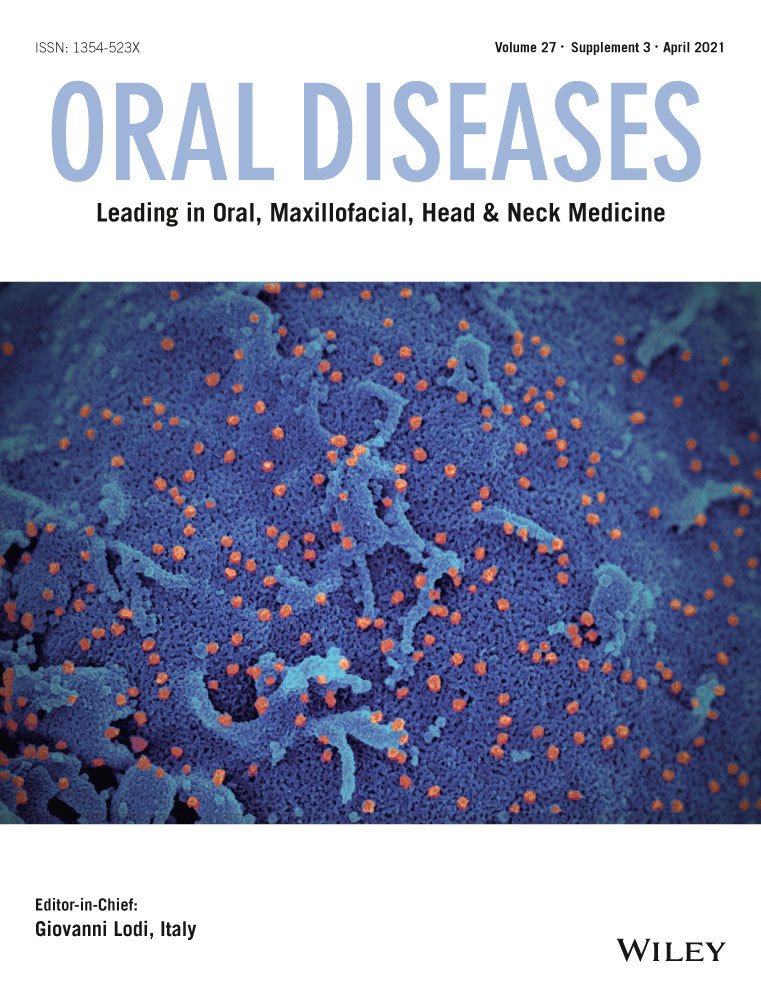Hyposalivation as a potential risk for SARS-CoV-2 infection: Inhibitory role of saliva
Corresponding Author
Nima Farshidfar
Student Research Committee, Shiraz University of Medical Sciences, Shiraz, Iran
Correspondence
Nima Farshidfar, Student Research Committee, School of Dentistry, Shiraz University of Medical Sciences, Ghom Abad Street, Shiraz, Iran.
Email: [email protected]
Contribution: Conceptualization, Investigation, Methodology, Project administration, Validation, Visualization, Writing - original draft, Writing - review & editing
Search for more papers by this authorShahram Hamedani
Oral and Dental Disease Research Center, School of Dentistry, Shiraz University of Medical Sciences, Shiraz, Iran
Contribution: Conceptualization, Formal analysis, Investigation, Methodology, Project administration, Validation, Visualization, Writing - original draft, Writing - review & editing
Search for more papers by this authorCorresponding Author
Nima Farshidfar
Student Research Committee, Shiraz University of Medical Sciences, Shiraz, Iran
Correspondence
Nima Farshidfar, Student Research Committee, School of Dentistry, Shiraz University of Medical Sciences, Ghom Abad Street, Shiraz, Iran.
Email: [email protected]
Contribution: Conceptualization, Investigation, Methodology, Project administration, Validation, Visualization, Writing - original draft, Writing - review & editing
Search for more papers by this authorShahram Hamedani
Oral and Dental Disease Research Center, School of Dentistry, Shiraz University of Medical Sciences, Shiraz, Iran
Contribution: Conceptualization, Formal analysis, Investigation, Methodology, Project administration, Validation, Visualization, Writing - original draft, Writing - review & editing
Search for more papers by this author
REFERENCES
- Collins, A. R., & Grubb, A. (1998). Cystatin D, a natural salivary cysteine protease inhibitor, inhibits coronavirus replication at its physiologic concentration. Oral Microbiology and Immunology, 13(1), 59–61.
- Dawes, C., Pedersen, A., Villa, A., Ekström, J., Proctor, G. B., Vissink, A., … Wolff, A. (2015). The functions of human saliva: A review sponsored by the World Workshop on Oral Medicine VI. Archives of Oral Biology, 60(6), 863–874. https://doi.org/10.1016/j.archoralbio.2015.03.004
- Irmak, M. K., Erdem, U., & Kubar, A. (2012). Antiviral activity of salivary microRNAs for ophthalmic herpes zoster. Theoretical Biology and Medical Modelling, 9(1), 21. https://doi.org/10.1186/1742-4682-9-21
- Iwabuchi, H., Fujibayashi, T., Yamane, G. Y., Imai, H., & Nakao, H. (2012). Relationship between hyposalivation and acute respiratory infection in dental outpatients. Gerontology, 58(3), 205–211. https://doi.org/10.1159/000333147
- Magister, Š., & Kos, J. (2013). Cystatins in immune system. Journal of Cancer, 4(1), 45–56. https://doi.org/10.7150/jca.5044
- Malamud, D., Abrams, W. R., Barber, C. A., Weissman, D., Rehtanz, M., & Golub, E. (2011). Antiviral activities in human saliva. Advances in Dental Research, 23(1), 34–37. https://doi.org/10.1177/0022034511399282




